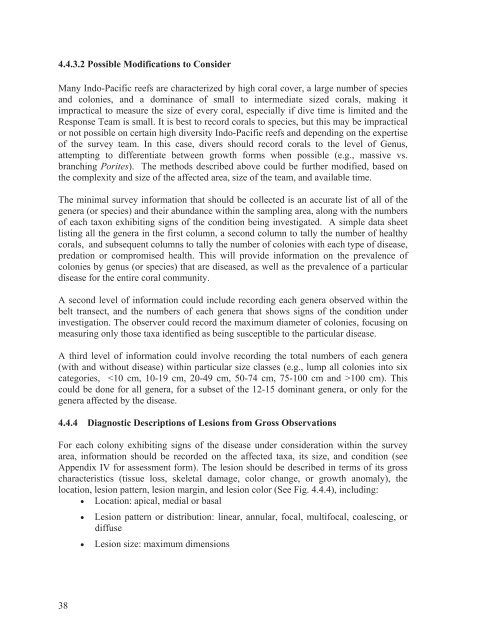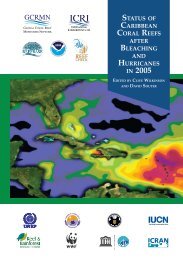Field Manual for the Investigation of Coral Disease Outbreaks
Field Manual for the Investigation of Coral Disease Outbreaks
Field Manual for the Investigation of Coral Disease Outbreaks
Create successful ePaper yourself
Turn your PDF publications into a flip-book with our unique Google optimized e-Paper software.
4.4.3.2 Possible Modifications to ConsiderMany Indo-Pacific reefs are characterized by high coral cover, a large number <strong>of</strong> speciesand colonies, and a dominance <strong>of</strong> small to intermediate sized corals, making itimpractical to measure <strong>the</strong> size <strong>of</strong> every coral, especially if dive time is limited and <strong>the</strong>Response Team is small. It is best to record corals to species, but this may be impracticalor not possible on certain high diversity Indo-Pacific reefs and depending on <strong>the</strong> expertise<strong>of</strong> <strong>the</strong> survey team. In this case, divers should record corals to <strong>the</strong> level <strong>of</strong> Genus,attempting to differentiate between growth <strong>for</strong>ms when possible (e.g., massive vs.branching Porites). The methods described above could be fur<strong>the</strong>r modified, based on<strong>the</strong> complexity and size <strong>of</strong> <strong>the</strong> affected area, size <strong>of</strong> <strong>the</strong> team, and available time.The minimal survey in<strong>for</strong>mation that should be collected is an accurate list <strong>of</strong> all <strong>of</strong> <strong>the</strong>genera (or species) and <strong>the</strong>ir abundance within <strong>the</strong> sampling area, along with <strong>the</strong> numbers<strong>of</strong> each taxon exhibiting signs <strong>of</strong> <strong>the</strong> condition being investigated. A simple data sheetlisting all <strong>the</strong> genera in <strong>the</strong> first column, a second column to tally <strong>the</strong> number <strong>of</strong> healthycorals, and subsequent columns to tally <strong>the</strong> number <strong>of</strong> colonies with each type <strong>of</strong> disease,predation or compromised health. This will provide in<strong>for</strong>mation on <strong>the</strong> prevalence <strong>of</strong>colonies by genus (or species) that are diseased, as well as <strong>the</strong> prevalence <strong>of</strong> a particulardisease <strong>for</strong> <strong>the</strong> entire coral community.A second level <strong>of</strong> in<strong>for</strong>mation could include recording each genera observed within <strong>the</strong>belt transect, and <strong>the</strong> numbers <strong>of</strong> each genera that shows signs <strong>of</strong> <strong>the</strong> condition underinvestigation. The observer could record <strong>the</strong> maximum diameter <strong>of</strong> colonies, focusing onmeasuring only those taxa identified as being susceptible to <strong>the</strong> particular disease.A third level <strong>of</strong> in<strong>for</strong>mation could involve recording <strong>the</strong> total numbers <strong>of</strong> each genera(with and without disease) within particular size classes (e.g., lump all colonies into sixcategories, 100 cm). Thiscould be done <strong>for</strong> all genera, <strong>for</strong> a subset <strong>of</strong> <strong>the</strong> 12-15 dominant genera, or only <strong>for</strong> <strong>the</strong>genera affected by <strong>the</strong> disease.4.4.4 Diagnostic Descriptions <strong>of</strong> Lesions from Gross ObservationsFor each colony exhibiting signs <strong>of</strong> <strong>the</strong> disease under consideration within <strong>the</strong> surveyarea, in<strong>for</strong>mation should be recorded on <strong>the</strong> affected taxa, its size, and condition (seeAppendix IV <strong>for</strong> assessment <strong>for</strong>m). The lesion should be described in terms <strong>of</strong> its grosscharacteristics (tissue loss, skeletal damage, color change, or growth anomaly), <strong>the</strong>location, lesion pattern, lesion margin, and lesion color (See Fig. 4.4.4), including: Location: apical, medial or basalLesion pattern or distribution: linear, annular, focal, multifocal, coalescing, ordiffuseLesion size: maximum dimensions38
















